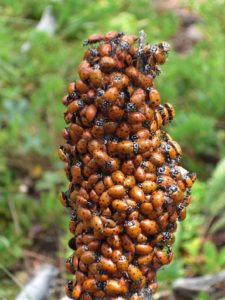Wildlife Wednesday: The Beetles Return
Another group of animals that return in the warmer weather of Springtime is the beetles. Now there are a ridiculous number of beetle species around the Houston area, but I wanted to focus on some of the more noticeable species that we’ve seen around the park this week during our classes and nature hikes.
 Ladybugs are all over the park right now, but we’ve seen mostly Asian Many-spotted Ladybird Beetles in our wildflower gardens and Pocket Prairie. This week, we finally spotted some of our native Convergent Ladybird Beetles (Hippodamia convergens) skulking around various plants, preying on aphids. They are best known for converging in large numbers on logs, rocks, and even the sides of homes in autumn and through the winter.
Ladybugs are all over the park right now, but we’ve seen mostly Asian Many-spotted Ladybird Beetles in our wildflower gardens and Pocket Prairie. This week, we finally spotted some of our native Convergent Ladybird Beetles (Hippodamia convergens) skulking around various plants, preying on aphids. They are best known for converging in large numbers on logs, rocks, and even the sides of homes in autumn and through the winter.
photograph by Drobibcorvette | Wikimedia

The Texas Eyed-Click Beetle (Alaus lusciosus) grows to about 2 inches long. They’re known for the loud clicks they make when they pop their bodies and jump suddenly. They’re quite noticeable, because of their size and the prominent false-eye spots on the pronotum, the exoskelatal shield covering the thorax. The large plump larvae feed on other insect larvae, and the adults feed mainly on nectar and other plant juices.
The Hardw ood Stump Borer (Mallodon dasytomus) grows to about 2 1/2 inches long, and can deliver a painful bite with their large sharp mandibles (though this is not an aggressive species, and only bites when grabbed). They live in and around dead rotten stumps and logs, where they prey on a variety of other insects, especially ants and their larvae. the wood boring larvae (grubs) may take 3-4 years to mature into adults!
ood Stump Borer (Mallodon dasytomus) grows to about 2 1/2 inches long, and can deliver a painful bite with their large sharp mandibles (though this is not an aggressive species, and only bites when grabbed). They live in and around dead rotten stumps and logs, where they prey on a variety of other insects, especially ants and their larvae. the wood boring larvae (grubs) may take 3-4 years to mature into adults!
Well thanks for joining us again this week for Wildlife Wednesday. If you found these beetles interesting, please come out to the park, and see if you can find some out along the trails!
See you soon,
Eric Duran
Staff Naturalist
Top photo of Convergent Ladybird Beetle by TJ Gehling | Flickr



